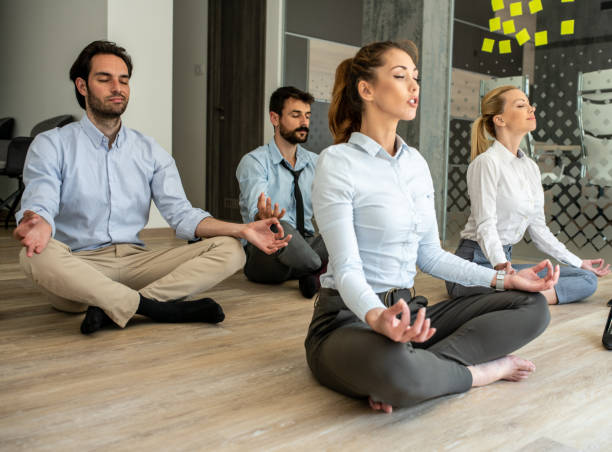In today’s fast-paced, hyper-connected work environments, maintaining focus and productivity can be a challenge. The constant demands, distractions, and pressure to perform can easily overwhelm even the most organized professionals. Meditation has emerged as a powerful tool to help individuals combat stress, improve focus, and enhance productivity in the Workplace Meditation Tips. Here’s a detailed guide to integrating meditation practices into your workday, designed to boost focus, reduce stress, and maximize efficiency.
Why Meditation in the Workplace Is Important?
Meditation is no longer just a wellness trend but an effective, scientifically-backed practice to improve mental clarity, focus, and emotional well-being. In fact, research has shown that regular meditation helps to:
Reduce Stress: Meditation activates the parasympathetic nervous system (the “rest and digest” system), lowering cortisol levels and reducing the mental and physical effects of stress.
Enhance Focus: Mindfulness practices improve concentration and attention span, which are crucial for completing tasks efficiently.
Boost Creativity: A calmer mind allows for better problem-solving and innovative thinking.
Increase Emotional Resilience: Meditation helps regulate emotions, leading to better interactions with colleagues and improved decision-making.
Improve Overall Productivity: By fostering mental clarity, reducing distractions, and calming the mind, meditation allows employees to accomplish more in less time.
Types of Meditation Practices for the Workplace
Meditation comes in many forms, but not all are suited for a work environment. Here are some of the most effective practices for enhancing focus and productivity in the office:
1. Mindfulness Meditation:
Mindfulness meditation involves focusing on the present moment without judgment. In the workplace, it helps individuals stay centered, maintain awareness of their surroundings, and combat the mental clutter caused by distractions.
How to Practice:
- Find a quiet space: If possible, take a break in a quiet area, such as a meeting room, or sit at your desk if there’s minimal disruption.
- Focus on your breath: Close your eyes, inhale slowly through your nose, and exhale through your mouth. Pay attention to the sensation of your breath as it enters and leaves your body.
- Stay present: If your mind starts to wander, gently bring your focus back to your breath without judgment. This helps build attention control.
Duration: Start with just 3-5 minutes, and gradually increase the duration as you become more comfortable.
2. Guided Meditation:
Guided meditation involves listening to an instructor (either in person or through an app or audio recording) who leads you through a meditation practice. This can include visualization, breathing exercises, or body scans, which are excellent for calming your mind during a busy workday.
How to Practice:
- Choose a guided meditation app or video, such as Calm, Headspace, or Insight Timer.
- Find a quiet space or use noise-canceling headphones.
- Listen to the guidance and follow the instructions.
Duration: Guided meditations are typically between 5 and 20 minutes, making them easy to fit into a workday.
3. Breathing Exercises (Pranayama):
Breathing exercises, derived from yogic practices, are a simple and highly effective way to calm the mind and focus. Pranayama techniques like deep belly breathing and alternate nostril breathing can help clear mental fog and improve concentration.
How to Practice:
- Deep Belly Breathing: Sit or stand with your back straight. Inhale deeply through your nose, allowing your abdomen to expand, and exhale slowly through your mouth. Focus solely on the sensation of the breath entering and leaving your body.
- Alternate Nostril Breathing: Sit in a comfortable position. Close your right nostril with your thumb and inhale deeply through the left nostril. Close the left nostril with your ring finger and exhale through the right nostril. Continue alternating nostrils for several rounds.
Duration: You can practice breathing exercises in short bursts, even just 2-3 minutes, or longer if needed.
4. Body Scan Meditation:
Body scan meditation involves mentally scanning your body from head to toe, identifying any areas of tension, and consciously relaxing them. This practice can help relieve physical tension that may have accumulated throughout the day and improve mental clarity.
How to Practice:
- Find a quiet, comfortable space to sit or lie down.
- Close your eyes and take a few deep breaths.
- Slowly bring your attention to each part of your body, starting from your toes and moving upward.
- As you focus on each part of your body, notice any areas of tension or discomfort and breathe into them to release the stress.
Duration: A typical body scan can last between 5 to 10 minutes.
5. Walking Meditation:
Sometimes, the best way to meditate is to move your body. Walking meditation involves mindfully walking while paying attention to your breath and the sensations in your body. This is a great option for those who find sitting still difficult or need to stretch their legs during the workday.
How to Practice:
- Find a quiet space to walk, such as a corridor, outdoor area, or even around your office.
- Walk slowly, paying attention to the movement of your body and your breath.
- Focus on each step, noticing the feeling of your feet touching the ground and lifting.
- Try to stay present, letting go of any distracting thoughts.
Duration: 10–15 minutes is ideal, but you can practice walking meditation for as long as you need.
Workplace Meditation Tips:
While the benefits of meditation are clear, the challenge for most professionals is finding the time and space to practice regularly. Here are some Workplace Meditation Tips an effective and manageable part of your daily routine:
1. Start Small:
If you’re new to meditation, don’t try to meditate for long periods right away. Start with just 3-5 minutes per session, gradually increasing the time as you become more accustomed to the practice.
2. Schedule It Into Your Day:
Treat meditation like any other important meeting or task. Set a specific time each day to meditate—whether it’s during your lunch break, first thing in the morning, or after a particularly stressful meeting.
3. Create a Dedicated Space:
If possible, designate a quiet space in your office or workspace where you can meditate without distractions. This could be a small area in a break room, an unused meeting room, or even a corner of your desk with noise-canceling headphones.
4. Use Apps and Tools:
There are a variety of meditation apps that can help guide you through your practice and provide structure. Apps like Headspace, Calm, and Insight Timer offer short, office-friendly meditations that can be easily accessed from your phone or computer.
5. Pair Meditation with Work Breaks:
Incorporating short meditative practices into your regular work breaks can significantly reduce burnout and fatigue. Consider using the 5-minute break you take to stretch as an opportunity for mindful breathing or quick meditation.
6. Practice Mindfulness in Everyday Tasks:
Even when you’re not meditating formally, you can integrate mindfulness into your workday. Practice being fully present during meetings, when replying to emails, or when speaking with colleagues. This helps reduce mental distractions and improves focus.
7. Encourage a Meditation-Friendly Workplace Culture:
If you’re in a leadership position, consider promoting mindfulness and meditation practices at your workplace. Offer quiet spaces for employees, suggest a meditation break, or even host group meditation sessions to build a supportive environment for mental wellness.
Final Thoughts:
Incorporating meditation into the workplace isn’t just about reducing stress; it’s about creating a more productive, focused, and resilient work environment. By practicing mindfulness, breathing exercises, or even a quick body scan, you can significantly enhance your ability to concentrate, solve problems, and handle the demands of your job. With regular meditation, you’ll not only improve your own productivity but also foster a more positive, balanced work atmosphere for those around you.
So, whether you’re in a high-stakes meeting or dealing with a tight deadline, taking just a few moments to meditate can lead to a calmer, clearer, and more productive workday.





